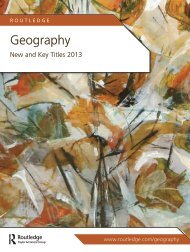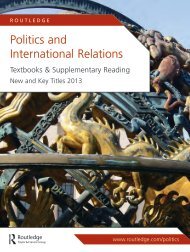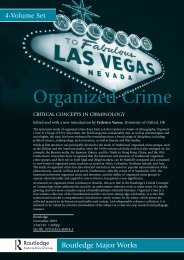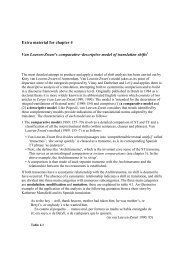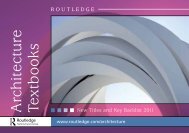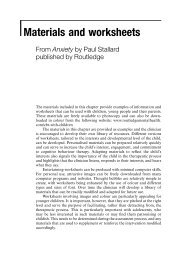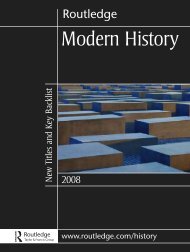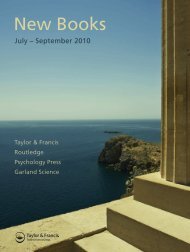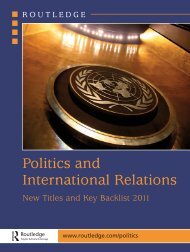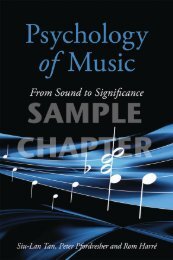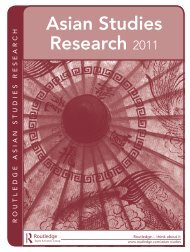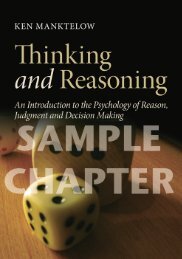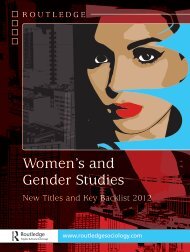Tim Burton: The Monster and the Crowd - A Post-Jungian Perspective
Tim Burton: The Monster and the Crowd - A Post-Jungian Perspective
Tim Burton: The Monster and the Crowd - A Post-Jungian Perspective
You also want an ePaper? Increase the reach of your titles
YUMPU automatically turns print PDFs into web optimized ePapers that Google loves.
24 Introduction<br />
In his book Sculpting in <strong>Tim</strong>e, Andrey Tarkovsky discusses <strong>the</strong> use of<br />
ready-made, intellectual <strong>and</strong> decipherable imagery in ®lmmaking. He<br />
considers such practices bad taste. Signs that are `®xed' by <strong>the</strong> director for<br />
<strong>the</strong> audience, images ready for consumption, are <strong>the</strong> ones that sti¯e <strong>the</strong><br />
viewer's imagination ra<strong>the</strong>r than widen his or her range of vision. Not<br />
surprisingly, perhaps, as a long-shot director, he links such `sign-making' to<br />
clever montage:<br />
`Montage cinema' presents <strong>the</strong> audience with puzzles <strong>and</strong> riddles,<br />
makes <strong>the</strong>m decipher symbols, take pleasure in allegories, appealing all<br />
<strong>the</strong> time to <strong>the</strong>ir intellectual experience. Each of <strong>the</strong>se riddles, however,<br />
has its own exact, word for word solution; so I feel that Eisenstein<br />
prevents <strong>the</strong> audience from letting <strong>the</strong>ir feelings be in¯uenced by <strong>the</strong>ir<br />
own reaction to what <strong>the</strong>y see. When in October he juxtaposes a<br />
balalaika with Kerensky, his method has become his aim, in <strong>the</strong> way<br />
that ValeÂry meant. <strong>The</strong> construction of <strong>the</strong> image becomes an end in<br />
itself, <strong>and</strong> <strong>the</strong> author proceeds to make a total onslaught on <strong>the</strong><br />
audience, imposing upon <strong>the</strong>m his own attitude to what is happening.<br />
(Tarkovsky, 1989: 118)<br />
Such methods, Tarkovsky argues, `are utterly inimical', <strong>and</strong> contradict `<strong>the</strong><br />
very basis of <strong>the</strong> unique process whereby a ®lm affects an audience.<br />
Directors obsessed with associative montage `make thought into a despot: it<br />
leaves no ``air'', nothing of that unspoken elusiveness which is perhaps <strong>the</strong><br />
most captivating quality of all art' (2000: 183).<br />
<strong>Tim</strong> <strong>Burton</strong> is no Eisenstein. An anti-intellectual ®lmmaker, he does not<br />
make an effort to create `signs'. He remains in <strong>the</strong> realm of <strong>the</strong> symbolic,<br />
operating with <strong>the</strong> images that are personally dear to him, which also<br />
happen to be so `loose' that <strong>the</strong>ir interpretive range is endless. Edward's<br />
blade-h<strong>and</strong>s, apart from <strong>Burton</strong>'s own inability to communicate (which is<br />
<strong>the</strong> most obvious interpretation), also represent <strong>the</strong> double-edge (<strong>and</strong> <strong>the</strong><br />
edginess) of creativity, <strong>the</strong> creator's de®ciency, his inner darkness, <strong>and</strong> <strong>the</strong><br />
inevitable tension between <strong>the</strong> creative intention <strong>and</strong> <strong>the</strong> ®nal result.<br />
A psychoanalytic approach ± Freudian, Lacanian, Kleinian, etc. ± tends<br />
to view human nature in a ®xedly negative light. While Freud's <strong>the</strong>ories are<br />
veiled with biological determinism, Lacan's ideas of <strong>the</strong> unconscious structured<br />
like a language display an equally fatalistic approach to <strong>the</strong> psychic life<br />
of man. Once trapped in <strong>the</strong> trans-individual symbolic order, or a variety of<br />
such orders, an individual cannot change his destiny. <strong>The</strong> Lacanian man is<br />
surrounded by endless rigid cultural signi®ers, <strong>and</strong> mourns <strong>the</strong> impossibility<br />
of controlling <strong>the</strong> process of signi®cation because <strong>the</strong> signi®ed will always<br />
escape, <strong>and</strong> <strong>the</strong> precious moment of communication will be lost. In o<strong>the</strong>r<br />
words, human civilisation is yet ano<strong>the</strong>r existentialist failure because <strong>the</strong><br />
http://www.jungarena.com/tim-burton-<strong>the</strong>-monster-<strong>and</strong>-<strong>the</strong>-crowd-9780415489713



